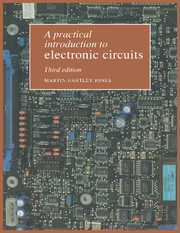Book contents
- Frontmatter
- Contents
- Preface to the third edition
- Preface to the second edition
- Preface to the first edition
- 1 Amplification and the transistor
- 2 The field-effect transistor
- 3 Thermionic valves and the cathode-ray tube
- 4 Negative feedback
- 5 Impedance matching
- 6 Semiconductor device characteristics
- 7 Amplification at high frequencies
- 8 Low-frequency signals, d.c. and the differential amplifier
- 9 Power supplies and power control
- 10 Pulse handling and time constants
- 11 Integrated circuit analogue building bricks
- 12 Positive feedback circuits and signal generators
- 13 Digital logic circuits
- 14 Microcomputer circuits and applications
- Appendix 1 Component identification
- Appendix 2 Transistor selection
- Appendix 3 Op amp data
- Appendix 4 Digital IC connections
- Appendix 5 Interfacing to the PC
- Bibliography
- Index
10 - Pulse handling and time constants
Published online by Cambridge University Press: 05 June 2012
- Frontmatter
- Contents
- Preface to the third edition
- Preface to the second edition
- Preface to the first edition
- 1 Amplification and the transistor
- 2 The field-effect transistor
- 3 Thermionic valves and the cathode-ray tube
- 4 Negative feedback
- 5 Impedance matching
- 6 Semiconductor device characteristics
- 7 Amplification at high frequencies
- 8 Low-frequency signals, d.c. and the differential amplifier
- 9 Power supplies and power control
- 10 Pulse handling and time constants
- 11 Integrated circuit analogue building bricks
- 12 Positive feedback circuits and signal generators
- 13 Digital logic circuits
- 14 Microcomputer circuits and applications
- Appendix 1 Component identification
- Appendix 2 Transistor selection
- Appendix 3 Op amp data
- Appendix 4 Digital IC connections
- Appendix 5 Interfacing to the PC
- Bibliography
- Index
Summary
Introduction
Our introduction to the transistor in chapter 1 used the device as a switch to turn a light bulb on and off. This is the simplest possible example of amplification, where the signal has only two voltage levels coresponding to the ‘on’ and ‘off’ conditions. Such a signal is shown in fig. 10.1; here, the two levels are zero and +5 V, the transition between the levels being virtually instantaneous so that the waveform is rectangular. Signals from radiation detectors such as the Geiger–Müller tube are of this form, whilst the enormous field of digital electronics is concerned entirely with trains of rectangular pulses. It is now common practice to transmit and record ordinary analogue signals in digital form because the signal has then only two levels and the various distortions which may occur in transmission and recording are readily corrected. This chapter is concerned with the handling of pulses and the modifications and distortions which may occur to them in various circuits.
‘Squaring’ a waveform
Any repetitive waveform may be converted to a rectangular wave merely by driving a simple voltage amplifier so hard that it is driven alternately into cut-off and saturation. Fig. 10.2 shows a circuit that will do this. If the input is fed with a sine wave of at least 5 V r.m.s. amplitude, the output will be a rectangular wave suitable for use with the various pulse-shaping experiments in this chapter.
- Type
- Chapter
- Information
- A Practical Introduction to Electronic Circuits , pp. 248 - 271Publisher: Cambridge University PressPrint publication year: 1995



